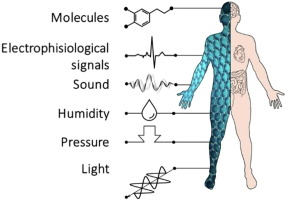Nano-bionics have the potential of revolutionizing modern medicine. Among nano-bionic devices, body sensors allow to monitor in real-time the health of patients, to achieve personalized medicine, and even to restore or enhance human functions. The advent of two-dimensional (2D) materials is facilitating the manufacturing of miniaturized and ultrathin bioelectronics, that can be easily integrated in the human body. Their unique electronic properties allow to efficiently transduce physical and chemical stimuli into electric current. Their flexibility and nanometric thickness facilitate the adaption and adhesion to human body. The low opacity permits to obtain transparent devices. The good cellular adhesion and reduced cytotoxicity are advantageous for the integration of the devices in vivo. Herein we review the latest and more significant examples of 2D material-based sensors for health monitoring, describing their architectures, sensing mechanisms, advantages and, as well, the challenges and drawbacks that hampers their translation into commercial clinical devices.

